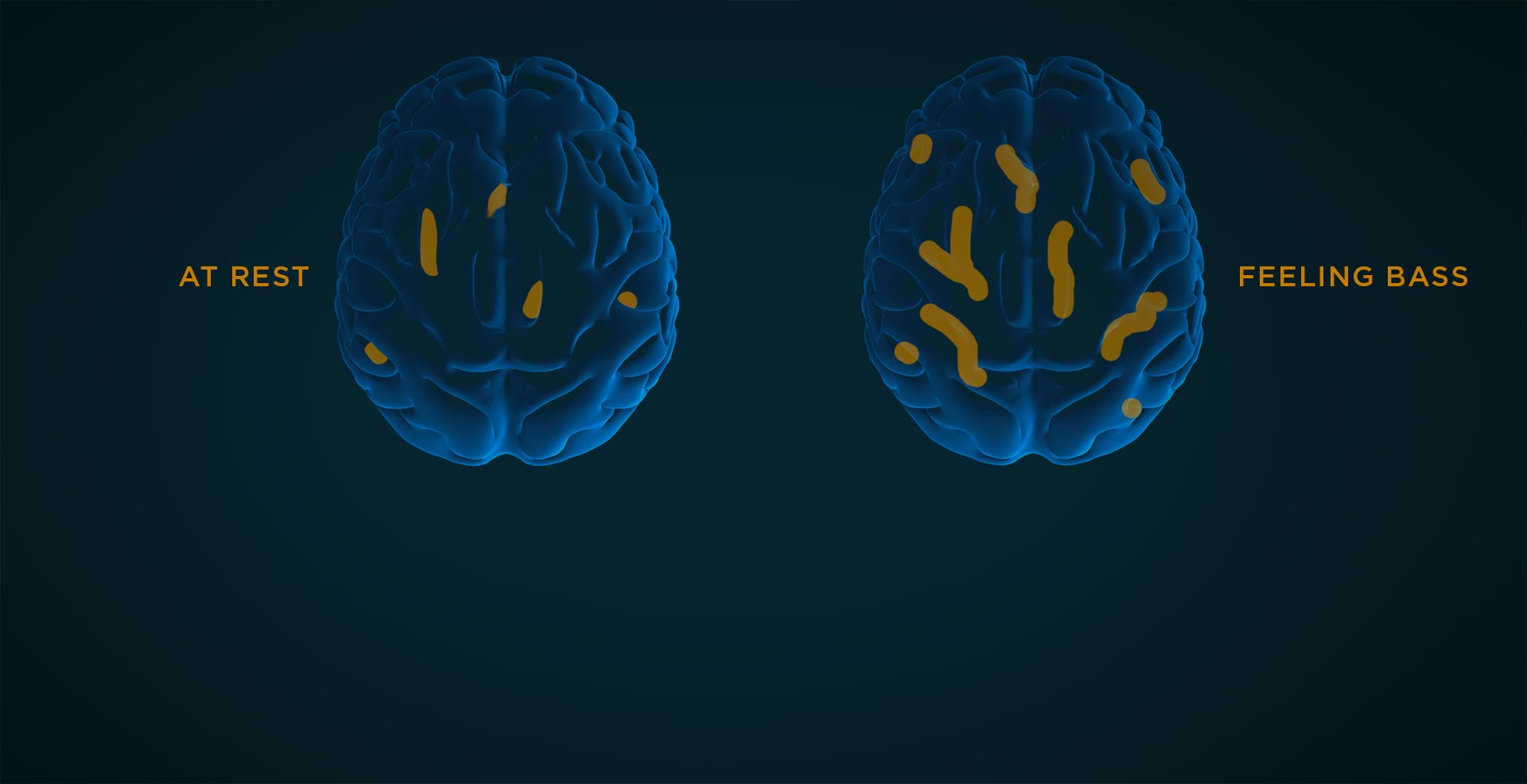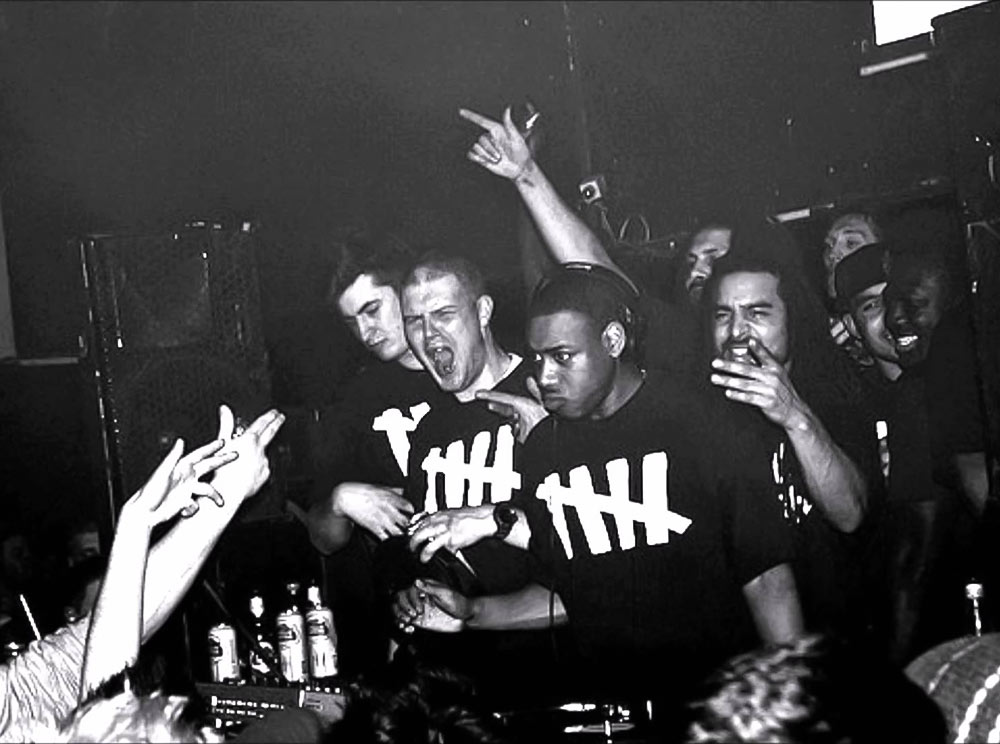
PART II
We have a huge quantity of intuitive and anecdotal data from artists, ravers, technologists, sociologists and psychologists – but in hard scientific terms, what do we know about the perception and effects of bass? To begin with, it is a bodily experience. Throughout your body, there are nerves which detect different types of sensation. Professor Sophie Scott of UCL explains: “you’ve got orientation and movement through space, you’ve got pain, you’ve got heat, you’ve got pressure, you’ve got what psychologists call ‘affective touch’ which is being stroked gently, and you’ve got vibro-tactile sensation, which is specifically the feeling of vibration – and each of these seem to have different dedicated receptors. So actually somatic sensation – what you feel in your body – appears to you to be all one thing, and in psychology there’s a tendency to describe anything that you feel as this one thing, as sensation, but it’s not, it’s quite a wide range of different types of information, one of which is vibration.”
Indeed, as her UCL colleague Hugh Montgomery, professor of intensive care medicine, points out, each of these types of “sensation” has its own neural pathways through the body to the brain – each of which have to be tested if there is the suspicion of nerve damage: “You would test that as part of a neurological examination – putting a tuning fork on your feet and hands to see if you can detect the buzz and detect when it starts and stops. And those sensors which detect vibration are present throughout your body. So yes, there are actual pathways other than from the ears being activated if you’re listening to something loud.”
So the signals that reach your brain from low-end vibrations are a very specific thing, distinct from what you experience from any other physical stimuli. But at the same time, they blur together with a very different sense: hearing. “What’s interesting about bass sounds,” says Scott, “is that they sit in the space where they overlap with that feeling. A lot of sounds that come through the air, you don’t feel viscerally, the frequencies are so high you experience it as sound, but not any other vibro-tactile sensation. Bass sound you do, though. It’s an overlap between two areas of sensation that we tend to treat as different – vibro-tactile sensation and sound. Of course they’re not different phenomena – they are exactly the same vibration coming through the air – but we have different organs for dealing with them. However, then in the brain they get merged back together into the experience of hearing that particular tone or sound.”
Now it appears that, as anyone used to experiencing or manipulating bass frequencies in a musical sense has likely intuited, this physical impact is indeed more basic and instant than sound that we hear purely in the higher frequencies: it operates on a more unconscious level than, say, lyrics and melodies do. Scott points to a difference between “sensation-to-action” brain operations which tend to take place in the brain-stem, and which we generally equate to reflex, instinctual or unconscious reactions, and more abstracted, high-level “classification” type processes which take place in the cortex, the area which is more developed in mammals and especially the human brain. So, your body and brain-stem are pre-empting any conscious associations you may have with the sound you’re experiencing, and reacting on a pre-conscious level.
The unconscious effect is more dramatic still if the sound is rhythmic. “A really good example,” says Scott, “is if you listen to a rhythm – just listen – and the rhythm is changed, you can get a threshold of how big that change needs to be before the person can detect it. Now if you get the subject to tap along to the rhythm, they will adapt their taps to much smaller changes than they can hear. As soon as you let people move with a rhythm, you see this much more implicit, much less under conscious control, much less within your awareness perception, reaction to sounds, that’s actually much more accurate and very quick, but that you’re not necessarily even able to report on because the classification system hasn’t kicked in at this point.” That is to say, if you can hear something and feel it at the same time, your perception of it through feeling is in some senses subtler and more accurate than your perception through hearing: the bassline rumble may be sending you extremely sophisticated signals.
Dr Mick Grierson of Goldsmiths College expands on this kind of instinctive response to rhythmic patterns: “Regularly spaced sound events can make brainwaves synchronise to them. As all sound events are basically low frequency when compared to most other audio signals, you can argue that bass plays a large part in that. Also, bass contains more energy than most other musical frequencies, so may or may not increase the likelihood of being able to drive what is called the Frequency Following Response. Some people now claim that this can place people in meditative, or altered states of consciousness – but although it’s well acknowledged within neuroscience, research is very limited, so nobody is yet sure what the ‘clean’ face of FFR is.”
Grierson is, incidentally, also a noise musician. “I spent quite a while exploiting it in gigs using audiovisual flicker, with noise and white light, then a range of pulsing frequencies with varying slopes. When I was doing it back then, people used to say it tripped them out quite a bit. I was doing it deliberately, to enforce the frequency following response, and I don’t talk about it much, but I did it for years. Then I did it with a bunch of psychologists and they got really annoyed and told me I should stop doing it because it was unethical and dangerous. In my experience, repetitive bass is a really easy, less invasive way of doing the same thing. Four on the floor anyone?” In other words, every time anyone is sending a bass pulse through a dancefloor with a strobe on, they are doing the kind of experiment that psychologists might consider dangerous!
Scott recognises the potential power for emotional manipulation here, pointing to the use of sonic effects in modern film and theatre using high-end audio reproduction but also in sound effects dating back to Shakespeare’s time and before. “There’s a reason the audience is called ‘audience’,” she says; “because in Shakesepeare’s time if you were a normal theatre-goer on the floor you wouldn’t be able to see much, you were hearing, it was audio. It was more like radio, the theatre was an engine for sound, an acoustic experience.” Those sound effects, whether it’s using Dolby surround to simulate a helicopter flying over an audience, or the cannonballs rolling down tracks that simulated thunder in old theatres, are things that stimulate the very primal, brain-stem, “sensation-to-action” reflexes, but can increasingly be extremely refined in their delivery and manipulation. There is now an increasing area of study in “archaeo-acoustics” in which architects and historians digitally reconstruct ancient spaces to try and understand how sound was heard in them – and indeed a lot of speculation about how sound was manipulated to create or manipulate religious experience in temples and cathedrals through history.
When we hear – and feel – bass, we’re touching on some very deep and subtle processes. There are echoes of our first, in-utero, understanding of language and music. We are stimulated in the zone that overlaps between our abstracted cognitive classifications and our rapid-response reflexes: between our conscious and unconscious perception. We feel the hypnotic effects of Frequency Following Response. Just as it penetrates and permeates solid matter, bass penetrates and calls into question boundaries between background and foreground, and even between self and non-self. All of these are fundamental to our understanding of who and what we are: yet none of them have been examined in depth in any real scientific or clinical way. Artists, musicians and technicians constantly produce dramatic effects and new ideas by manipulating low frequencies, and of course it is precisely the arena which SUBPAC operates in: allowing those low frequency responses to be experienced and examined in entirely new contexts. Bass is both primal and hyper-modern, but it is anything but basic. It and its effects map out an undiscovered country, one which is ripe for exploration.




